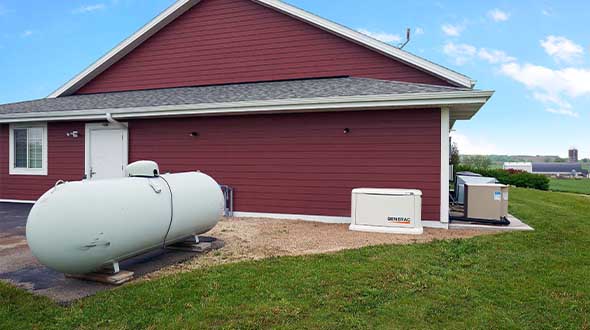Propane marketers diversify through power technologies
Propane marketers who adopt new technology are creating added efficiencies that can boost their bottom line. By using technology and participating in the growing power generation sector, marketers can further diversify their revenue-generating opportunities outside traditional home heating, filling an increased consumer need for reliable energy and contributing to a decarbonized future.

Propane-fueled power generators offer solutions for those impacted by electric grid outages or severe weather events such as wildfires and blizzards. (Photo courtesy of Kohler Co.)
It’s a win-win proposition, say those in the technology and power generation spaces. Marketers are securing their businesses for the future while promoting propane as a resilient, off-grid energy source.
The instability of the electric grid in the wake of natural disasters and extreme weather events and the decision by some utilities to initiate power shutoffs, particularly in California, are fueling a stronger need for propane marketers to meet changing consumer demands and become that trusted energy adviser for their customers.
“Grid power failures come in many shapes and sizes, and can be caused by a variety of natural events depending upon your zip code,” says Mark Leitman, director of the power division at Santa Rosa, California-based Blue Star Gas.
No longer can a marketer focus solely on propane delivery. When a marketer also promotes and provides power generation solutions, consumers can rest assured knowing their most basic power needs are being met, erasing any anxieties about the next power shutdown, severe weather event or wildfire.
“We’re at a point where backup power should be considered as an essential system of the home or business, during any construction or major remodeling project,” Leitman says.
Increasingly, propane marketers are offering customers power generation solutions, backed by technological support. In doing so, marketers are establishing new sources of revenue, increasing burner tips and growing gallons.
Prevailing partnerships
High-profile partnerships, which gained traction in 2021, are aiding the effort.

Backup power from propane-fueled generators, with support from tank monitor technology, can provide an added layer of security and protection for customers. (Photo courtesy of Generac)
The progression in propane-fueled power generation needs and the need for accompanying propane industry support are among the reasons Generac took steps to partner with tank monitoring company Tank Utility. Generac had been a minority investor in Tank Utility since 2016 and, citing the growth seen during that time, acquired the remaining shares in the Boston company last year.
“Generac believes that the Tank Utility monitoring platform can provide even further value to our dealers and peace of mind to our home standby generator owners,” Generac says in a statement to LP Gas.
Tank Utility launched in the business-to-consumer space and now serves both propane marketers and generator dealers. As part of its company, Generac says, Tank Utility will look to continue its growth trend while offering propane marketers access to a global supply chain and R&D facilities, as well as provide new business opportunities and increased focus on quality and innovation in delivered fuels.
“Generators are becoming much more mainstream, and they’re being utilized to balance the electric grid on a much more frequent basis,” says Aaron Gress, chief revenue officer at Tank Utility. “If you’re a propane company, you may want to start getting in the business of installing generators.
“Generators give propane [marketers] access to an additional revenue source but also ongoing gallons and burner tips.”
According to Generac, backup power, whether portable, home standby or from a solar-based battery storage system, provides a layer of security and protection for customers.
The company’s permanently installed home backup generators run on natural gas or propane. Propane-fueled generators range in size from 7.5 kilowatts (kW) to 60 kW, including the new Guardian 26-kW home standby generator. On the commercial and industrial side, Generac offers propane-fueled generators ranging in size from 25 kW to 150 kW.
Generac views its partnership with Tank Utility as another step in becoming a leader in energy technology solutions. The added visibility provided by Tank Utility, it says, eliminates wasted deliveries and increases fuel drop sizes for greater efficiency per delivery because customer tank levels are tracked in real time.
“The partnership between Generac and Tank Utility is so valuable because putting a monitor on that generator customer is 100 percent necessary,” Gress says.
Marketer methods
Gress asks: Why can’t a propane marketer deliver propane and install generators?

Partnerships among propane marketers, tank monitoring providers and generator manufacturers are taking shape. (Photo courtesy of Generac)
He points to SchagrinGas, serving Delaware, Maryland and Pennsylvania, as one company selling, installing and servicing standby power generators to homeowners and businesses. The propane marketer formed a partnership with Tank Utility after meeting at a Generac dealer conference.
“Over the past 20 years, home standby generators have gone from a luxury item to a ‘must have’ for many people,” says Mark Wood, vice president of operations at SchagrinGas, whose company services about 1,500 generator customers and has deployed about 2,000 tank monitors.
In addition to weather events, more “work from home” customers owing to the global pandemic have contributed to a sustained increase in generator demand, Wood says.
Meeting that demand is another way for SchagrinGas to serve as that “energy expert” – a term promoted on company vehicles – for its customers.
“We want to build long-term relationships with our customers, not just as a fuel delivery company but as experts in energy and home comfort that enhance and secure their way of life,” he says.
On the West Coast, Blue Star Gas launched its power division in 2021 as it now sells, installs and services Kohler’s generator line.
The majority of Kohler’s backup applications in the residential and light commercial space range from 10 kW to 150 kW. A 20-kW model, adequate for many homes, will consume 2.25 gallons of propane per hour at an average load of 50 percent capacity, Leitman says.
Though it views backup power as an essential need for customers, Blue Star Gas is focused on the bigger picture of earning a customer for life.
“We’d love to provide a power solution, maintain it throughout its life, provide an energy source for the customer and even be there to offer other products that the customer may need, such as space heaters or water heaters,” Leitman says.
Emerging technologies
In addition to the technology that aids marketers and customers in fueling generators, the power generation sector is benefiting from its own improved technologies across applications.
Tucker Perkins, president and CEO of the Propane Education & Research Council, participated in a session about emerging technologies during the World LPG Association’s LPG Week in December.
Perkins used the global platform to explain “the breadth” of power generation applications, such as prime, backup, remote, combined heat and power (CHP) and mobile/towable units.
He also suggested a change on the horizon in how marketers sell LPG and how consumers think about their propane provider.
“We firmly believe [CHP] is the future of power generation and LPG use residentially and commercially,” he says, speaking of a system that produces electricity and heat on-site and at the point of use.
Perkins also addressed the growing use of fuel cells and microgrids, the latter finding a place in areas where electricity is unreliable or costs are high.
“Think of it as a self-sufficient system where you get your power, your heat, your hot water – whatever you need,” he says of microgrids. “It can be or not be grid connected. Most of the work today is grid connected but has the capacity to do black start. If there was no grid, the system could operate independently.”
Emerging power generation technologies are growing increasingly important in a world where the grid is no longer reliable, Perkins adds.
Over the next 10 years, Generac says, the way consumers get their power and the knowledge and control they have over it is going to change dramatically.
“Diversification and new revenue streams are a big part of this for the propane industry,” Gress says. “This is how the propane industry can participate in the electrify-everything movement.”
What marketers are saying about technology
LP Gas asked marketers what technology has had the greatest impact on business and which technologies they plan to explore in 2022.
“Tank monitoring is going well for us, and we will continue to implement that as fast as we can.” – Arkansas marketer
“In-vehicle GPS and camera systems. Also, tank monitors for storage and retail customer tanks.” – Texas marketer
“New routing and customer service software upgrade.” – New York marketer
“We are internally developing software capable of handling our fuel, propane and transportation side of our business.” – California marketer
“Monitors with meter [equal] remote billing capability.” – Florida marketer
“Remote tank monitoring combined with centralized real-time dispatch and tracking of trucks has made delivery more efficient.” – Texas marketer
“We will be focusing on going more digital: paperless billing, online orders, online payments.” – Oklahoma marketer
“Communicating with customers more through text and emails.” – Wisconsin marketer
“Tank monitors have been very successful for my business. The ability to make efficient deliveries to an ever-growing customer base has been pivotal.” – New York marketer
“GPS tracking for vehicles. We plan on upgrading our back-office computer system.” – Michigan marketer
“Technology that improves both the customer experience and company efficiencies without causing disruption is important and smart. The movement to ‘green energy’ and ‘zero carbon footprints’ is real, and marketers should be getting smart on this topic now.” – Kansas marketer
















